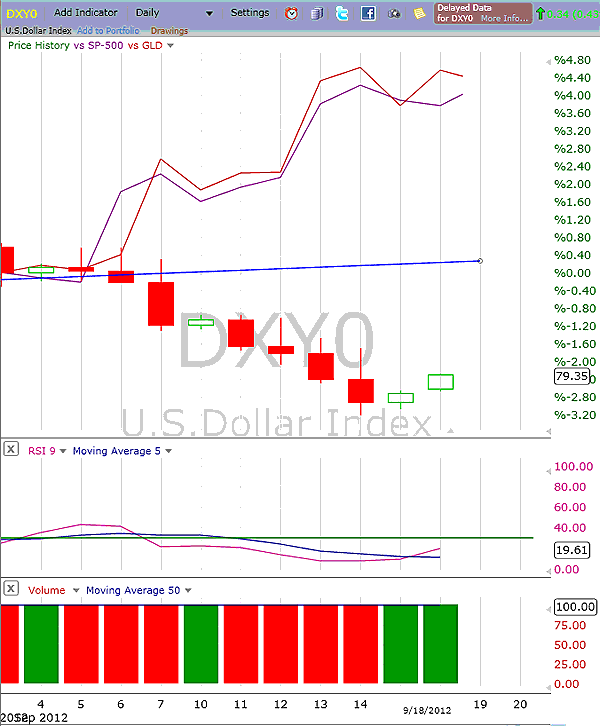Position: N/A
| On September 13, 2012, Federal Reserve chairman Ben
Bernanke ended speculation with his announcement that the Fed would
begin a third round of quantitative easing (QE3) by spending $40 billion
a month of mortgage-backed securities (MBS). But unlike QE1 and QE2, this latest QE program has no expiration date. The move followed on the heels of a similar move by European central bank president Mario Draghi a few days earlier to launch its Outright Monetary Transaction (OMT) program to buy the government bonds of distressed European nations. And while the two programs are patently different in detail, they both have the same broadcasted goal: to boost economic growth and reduce unemployment. Not broadcasted was the timing of the Fed's announcement with the surreptitious goal to provide a short-term lift to November 6. As Figure 1 shows, investors began to bet that QE on both sides of the pond was a forgone conclusion in the first week of September. In the first two weeks of September, the Standard & Poor's 500 gained 4%, GLD was up 4.4%, and the US Dollar Index fell 2.5%. So to gain 400 basis points, it cost the US dollar 250 basis points, leaving the nondollar gain of 150 basis points (1.5%). |

|
| FIGURE 1: DXY, SPX, GLD, DAILY. Here's a daily chart comparing the US Dollar Index (DXY), the S&P 500 in purple, and the SPDRS Gold Trust ETF (GLD) in orange since the beginning of September 2012. |
| However, if we look at the same chart since early October 2008
when the first round of quantitative easing began, we get a longer-term
view of the effect that QE programs have had in real terms (see Figure
2). Since then, GLD is up 100%, the SPX has gained 16%, and the DXY is
basically flat, compared to the basket of other currencies against which
it is measured. |

|
| FIGURE 2: DXY, SPX, GLD, WEEKLY. Here's a weekly chart showing the longer-term relationship between the DXY, SPX and GLD. |
| When measured in gold, the S&P 500 has lost nearly 50% since October 2008. In a September 17, 2012, Bloomberg interview (http://goo.gl/rzhwT ), Frank Holmes of US Global Investors was asked if gold could go to $2,000 per ounce thanks to the latest round of quantitative easing. He gave this target a 12-month window. "Whenever you have negative real interest rates, gold rises," he says. In a healthy economy, interest rates generally run about 2% above the inflation rate, but in today's reality, 5% interest rates would be devastating to the economy, Holmes said. When asked what the "craziest" gold price target he'd heard lately, Holmes replied that if you looked in terms of money supply (M2) growth, gold should be worth $7,000 per ounce. But if the world were to go back to the days of the Bretton Woods agreement pre-August 1971 when gold was convertible into dollars, gold would be worth $40,000 per ounce. Although Holmes doesn't see either of those scenarios happening anytime soon, here is another fact for traders and investors to consider. Since July 1999, when the US stocks peaked in gold terms, the S&P 500 has lost 85% of its value when priced in gold. Given the current penchant for central banks to print their way to prosperity, don't expect this trend to end anytime soon. |
No comments:
Post a Comment
Note: Only a member of this blog may post a comment.